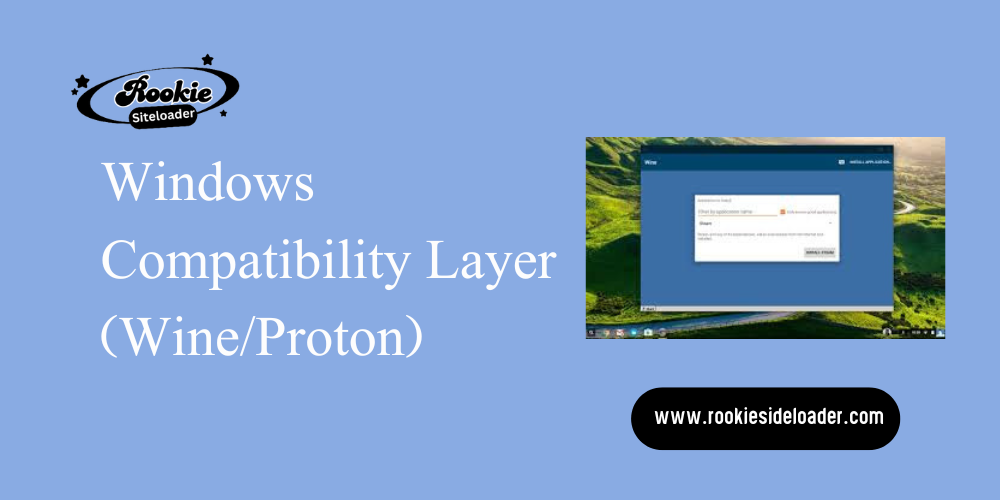Table of Contents
ToggleIntroduction
Welcome, fellow Linux enthusiasts! If you’re running a powerhouse distribution like Ubuntu, Fedora, or Arch, and you’re looking to get into VR sideloading, you’ve hit a technical roadblock. Rookie Side Loader (RSL) is designed exclusively for Windows, but the open-source spirit of Linux always provides a way!
As an expert SEO content writer with 15 years of experience in sideload applications and games, I understand the frustration of finding that the essential tools are locked behind a proprietary OS. You’ve likely searched how to download Rookie Side Loader only to find a Windows executable.
This definitive guide will cut through the noise and provide two verified methods for getting RSL or a native alternative working on your Linux machine. We’ll explore the necessary setup using compatibility layers like Wine, discuss the limitations, and introduce you to the Linux-native projects that tap into the same content mirrors.
Forget dual-booting; it’s time to make your Linux machine a VR sideloading powerhouse!

Method 1: The Windows Compatibility Layer (Wine/Proton)
Since the original Rookie Side Loader is a Windows .exe application (not a direct Rookie Side Loader download apk), the most straightforward way to run it on Linux is by using a compatibility layer like Wine or Proton (Valve’s modified version of Wine).
This method allows you to run the rookie sideloader download executable, but success is not guaranteed, and it requires careful configuration.
Getting the Rookie Side Loader Executable
Before attempting the Linux setup, you need the RSL client itself.
- Source the Files: The only way to get the true RSL is through a rookie sideloader download from the official community mirrors or verified GitHub repository, as it is a PC client. Do not look for an android sideloader download that is a different kind of application entirely.
- Extract Safely: Extract the compressed Windows files into a new, clean directory on your Linux system (e.g., ~/RSL_Linux).
Setting Up the Wine/Proton Environment
RSL often uses the .NET Framework and specific Windows services that can clash with Wine. You must create a clean environment, known as a Wine Prefix.
- Install Wine & Winetricks: Ensure you have the latest stable versions of Wine and Winetricks installed via your distribution’s package manager (apt, dnf, or pacman).
Create a Prefix: Create a dedicated 64-bit Wine prefix for RSL:
Bash
WINEPREFIX=~/.wine/rsl WINEARCH=win64 winecfg
Install Dependencies: Use Winetricks to install the necessary Windows components that RSL relies on, such as the .NET Framework (the specific version required by RSL).
Bash
WINEPREFIX=~/.wine/rsl winetricks dotnet48
Run RSL: Navigate to the folder where you extracted the RSL files and run the executable using your new prefix:
Bash
WINEPREFIX=~/.wine/rsl wine Rookie.exe
The Major Hurdle: ADB and USB Passthrough
Running the RSL graphical interface (GUI) is usually the easy part. The massive hurdle is getting the Windows application (running inside Wine) to reliably communicate with your VR headset via Android Debug Bridge (ADB) over USB.
- Native ADB: RSL often relies on its bundled Windows version of ADB. Even if you install the native Linux android-tools package, RSL may ignore it.
- USB Permission: You must ensure your user has the correct permissions to access the USB device (your VR headset) directly. This usually involves adding UDEV rules. If the Linux host doesn’t properly share the USB device with the Wine environment, RSL cannot detect the headset, rendering the rookie sideloader download useless for direct installation.
Expert Insight: Many users report that while the Wine/Proton method launches RSL and downloads games, the final step of installing the game to the headset often fails due to an unreliable ADB connection. If this happens, move to Method 2.
Method 2: The Native Linux Alternative (QRookie)
Linux users often create native alternatives to popular Windows-only tools. For sideloading, the community has developed QRookie, an open-source, native Linux application that accesses the same public game mirrors as Rookie Side Loader. This is the most reliable method for a true Linux setup.
QRookie: Your True Android Sideloader Download Solution
QRookie is built specifically for Linux and macOS, leveraging native libraries for a stable connection. Think of it as the spiritual successor for anyone looking for a direct Linux-based Android sideload download.
- QRookie Download: You don’t need to struggle with how to download Rookie Side Loader for Linux; you download QRookie! The best source is usually Flathub, the official repository for Flatpak applications, which ensures stable dependencies across all major Linux distributions.
Install ADB: You must ensure the native Linux ADB tools are installed.
For Debian/Ubuntu
sudo apt install android-tools-adbFor Arch/Manjaro
sudo pacman -S android-toolsInstall QRookie (Flatpak Recommended):
flatpak install flathub io.github.glaumar.QRookie
flatpak run io.github.glaumar.QRookieSetting Up Linux ADB Permissions (UDEV Rules)
Even with native ADB, Linux needs permission to talk to the specific USB ID of your VR headset. If you can’t see your device, you need UDEV rules.
- Find Device ID: Run lsusb with your headset plugged in. Look for the vendor ID (VID) and product ID (PID) associated with the headset (often Meta/Oculus is 2833:0180 or similar).
Create Rule File: Create a new UDEV rule file:
sudo nano /etc/udev/rules.d/51-android.rulesInsert Rule: Add the rule, substituting your device IDs and username:
SUBSYSTEM=="usb", ATTR{idVendor}=="<VID>", ATTR{idProduct}=="<PID>", MODE="0666", OWNER="<your-username>"Apply Changes: Restart UDEV to apply the new permissions:
sudo udevadm control --reload-rulessudo udevadm trigger- Now, when you launch QRookie, your headset should be reliably detected, bypassing the ADB limitations of the original RSL.
The Virtual Machine Alternative
If both Wine/Proton and the native alternatives fail, the final, guaranteed solution for running the original Windows-based download Rookie Sideloader client is to use a virtual machine (VM).
Installing RSL Inside a Windows VM
This method is guaranteed to work because RSL is running in its intended environment.
- Virtualization Setup: Use a virtualization tool like VirtualBox or QEMU/KVM to install a minimal version of Windows 10/11.
- Network Bridging: Critically, configure your VM’s network adapter to use bridged networking, not NAT. This allows your VM to see your local network directly, which is vital for Wireless ADB to function correctly.
- USB Passthrough: Configure the VM settings to enable USB Passthrough for your VR headset. This redirects the physical USB connection directly from the Linux host to the Windows VM.
- Run RSL: Inside the VM, perform the official rookie sideloader download and installation. Since the environment is pure Windows and has direct USB access, RSL will detect and install games to your headset reliably.
Conclusion: Linux is sideloading ready!
Getting the full functionality of the Rookie Sideloader download on Linux requires a bit more effort than on Windows, but it is entirely achievable. Whether you choose the complex path of running the Windows .exe through a compatibility layer or the simpler, more stable path of using a native tool like QRookie, you can successfully manage your VR content.
Remember that the original rookie sideloader download APK is not a real product; the true power lies in the PC client, which you can now leverage from your favorite Linux distribution. Happy sideloading!
FAQs:
I can’t find a direct Rookie Sideloader download APK. Why?
The core Rookie Side Loader application is a Windows PC client used to download and push files to your VR headset. It is not an Android sideloaded download or an app that runs directly on the headset (the APK). You must download the Windows executable (.exe) to your Linux PC and run it through a compatibility layer or VM.
Does Proton/Wine guarantee that the original RSL will work?
No. Proton/Wine is designed for running games, not complex file management and ADB clients. While the RSL interface usually launches, the critical function of detecting and installing to the headset via USB often fails due to USB and ADB communication issues within the Wine environment.
What is the best way to download Rookie Side Loader for a Linux user?
The best way is to use a native Linux alternative like QRookie. It connects to the same content mirrors but uses native Linux libraries for a stable ADB connection, bypassing the headaches of running the Windows .exe. You can usually find QRookie on Flathub.
Is there an Android sideloading download that runs on the headset itself?
Yes, there are a few tools that allow you to download content directly onto the headset without a PC, but they are separate applications. Rookie Side Loader is strictly a PC-to-headset sideloading manager.
How do I ensure my headset is detected after I download Rookie Side Loader (or QRookie)?
You must correctly set up UDEV rules on your Linux machine. This grants the ADB process (and the sideloading application) permission to read and write to the headset’s specific USB port. This step is essential for any Linux-based sideloading tool.
Latest Post:
- Using Rookie Side Loader on Linux: A Complete Setup Guide
- Top Multiplayer Games on Rookie Side Loader: How to Play with Friends
- Rookie Sideloader Multiplayer Support: What Works on Quest 2 & 3
- Joining the Rookie Side Loader Community: Discord and Server Status Updates
- How to Create and Share Voice-Enabled Tutorials for Your Sideloaded Apps















